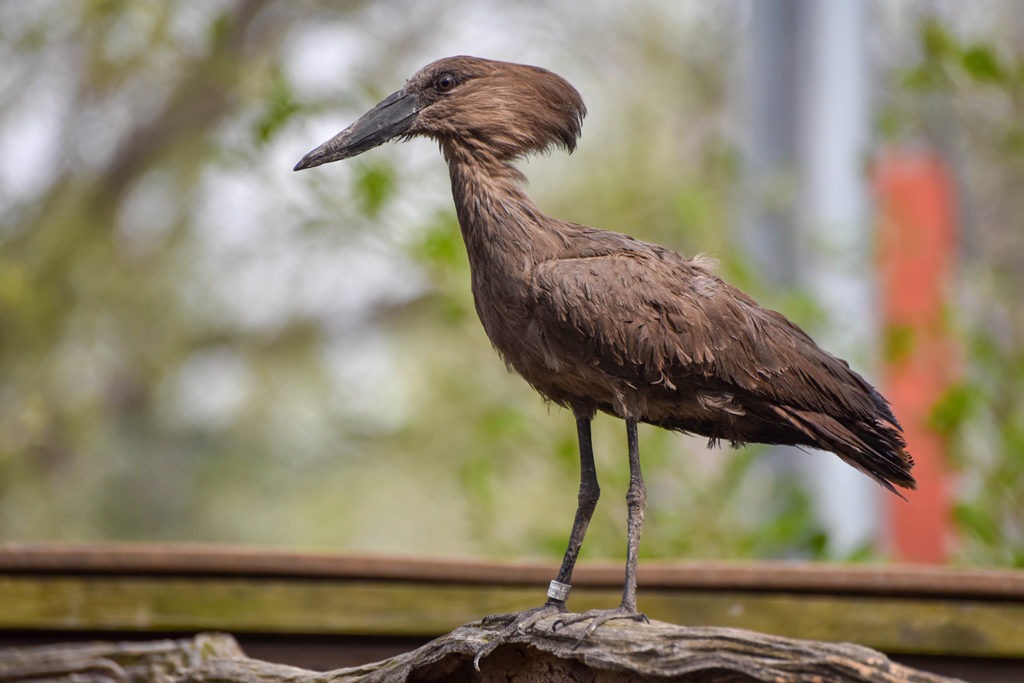Overview
“Where I live”
Hamerkops are widely dispersed throughout sub-Saharan Africa. They live in diverse habitats, from forest to semi-desert, anywhere where water is accessible. They frequent lakes, rivers, marshes, temporary seasonal ponds, and man-made waterways such as dams and irrigation channels. Hamerkops are most often seen in savannahs and woodlands, and may be only seasonally resident in semi-arid areas. They can be seen in the African Aviary exhibit of the Maryland Zoo.
“How I live there”
Hamerkops occupy well-defined territories that they rarely leave. These birds normally occur in pairs but can gather in groups of up to 50 birds, although usually closer to 10.
Like storks and herons, hamerkops are wading birds that forage for food in shallow water. They feed mainly on frogs and fish. They may stir the water with their feet or flap their wings to startle prey. Hamerkops also feed in flight, gliding over open water and dipping down to grab fish. Hamerkops are good hunters but often get robbed of their prey by bigger birds like the Fish Eagle, so they must catch many fish to satisfy their appetite.
“Making my mark”
Hamerkops are known for their huge, domed nests. They build the biggest nests of any bird in Africa! Pairs build a nest together, using hundreds of twigs and other items. A finished nest may contain as many as 8,000 items and weigh over 50 pounds. No matter how big, though, a hamerkop nest is accessed by only one small entrance hole.
Hamerkop nests attract many other species of wildlife. Verreaux’s eagle owls, Gray kestrels, and barn owls sometimes take over hamerkop nests, evicting the rightful residents. Smaller mammals such as gennets sometimes take up residence in hamerkop nests, as do other species of bird such as weaver birds, mynas, and pigeons that will attach their own smaller nests to the main nest. Monitor lizards and snakes often raid hamerkop nests to take eggs, and snakes may stay behind to occupy the nests as shelter. Old nests are quickly occupied by other hole-nesting birds such as the Egyptian goose, the Pygmy goose, or the Knob-billed duck.
“What eats me”
Monitor lizards and snakes often prey upon hamerkop eggs and chicks, resulting in an estimated 50% of eggs and 30-40% of chicks being lost to predation. If a hamerkop makes it to adulthood, it has a good chance of living a long life. The mean adult lifespan is about 20 years.
Raising Young
Hamerkops often gather near nesting sites for social courtship displays. Many birds start calling all at once while running around each other in circles with crests raised and wings fluttering. Males may pretend to mate with females during this courtship display, but it’s only ceremonial. Actual mating occurs when a pair is building a nest.
Females lay 3-7 eggs per clutch and males and females take turns sitting on the eggs during the incubation period, which lasts about 30 days. Both parents help feed the chicks once they hatch out. Chicks are ready to fly after about 50 days. They continue to return to the nest for two weeks after first flight and may roost together in the nest for another month before dispersing.
Conservation
Hamerkops are listed as a species of least concern by the IUCN, the world’s leading conservation organization. These birds are abundant throughout their range and are rarely persecuted by people because traditional folklore contends that they have magical powers.
Taxonomy
- Kingdom: Animalia
- Phylum: Chordata
- Subphylum: Vertebrata
- Class: Aves
- Order: Pelecaniformes
- Family: Scopidae
- Genera: Scopus
- Species: umbretta


